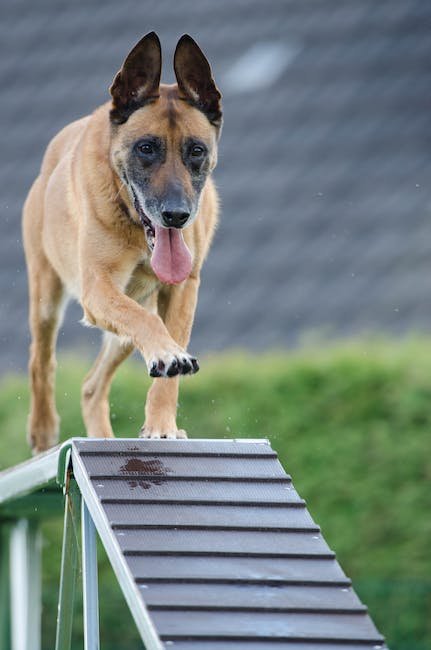Picture this: a dog calmly trotting over to a small, well-designed box, sniffing it curiously, and promptly relieving itself with precision. No, this is not a scene from a parallel universe where dogs have magically transformed into feline creatures. Believe it or not, training a dog to use a litter box is a fascinating concept that has gained considerable attention among pet owners and trainers alike. But, can dogs truly be taught to utilize a litter box? In this article, we delve into this intriguing question, providing you with the answers you seek. So, prepare to discover the truth about this alternative bathroom solution for our four-legged friends.
Table of Contents
- The Pros and Cons of Training a Dog to Use a Litter Box
- Finding the Right Litter Box for Your Dog’s Needs
- Step-by-Step Guide to Successfully Training Your Dog to Use a Litter Box
- Troubleshooting Common Issues During the Training Process
- Useful Tips and Recommendations for Maintaining a Clean and Odor-Free Litter Box
- Q&A
- The Conclusion

The Pros and Cons of Training a Dog to Use a Litter Box
Pros
Training a dog to use a litter box comes with its share of benefits:
- Convenient: Having a litter box for your dog can be incredibly convenient, especially if you live in an apartment or have a busy schedule. You won’t have to rush home or take them outside in bad weather. Just like cats, dogs can be trained to eliminate in a designated spot indoors.
- Hygienic: By using a litter box, you can keep your home cleaner and more sanitary. The litter helps absorb odors and contains any mess, making cleanup a breeze. Plus, it reduces the risk of your furry friend stepping on something harmful outside.
- Travel-friendly: Training your dog to use a litter box can come in handy when traveling. It provides familiarity and a consistent method for them to relieve themselves, making trips less stressful for both you and your pet.
Cons
While training a dog to use a litter box has several advantages, it also has a few drawbacks to consider:
- Confusing for some dogs: Not all dogs take naturally to litter box training. Some may find it confusing and struggle to understand the concept, potentially leading to accidents in the house.
- Requires patience and consistency: Training a dog to use a litter box requires time, patience, and consistent reinforcement. It may take longer for certain dogs to fully grasp the idea and become reliably litter box trained.
- May hinder outdoor potty training: If your ultimate goal is to have your dog eliminate outside, litter box training might create confusion. Some dogs might struggle to differentiate between elimination indoors and outdoors, leading to difficulties in potty training.
Ultimately, whether training your dog to use a litter box is the right choice depends on your lifestyle, your dog’s personality, and your training goals. Consider these pros and cons carefully to make an informed decision that suits both you and your furry friend.

Finding the Right Litter Box for Your Dog’s Needs
Dogs have specific needs when it comes to their litter boxes. Choosing the right one is crucial to ensure their comfort and hygiene. Consider these factors to find the perfect fit:
- Size matters: Take into account your dog’s breed and size when selecting a litter box. A small box may be uncomfortable for larger breeds, while a larger box could overwhelm a smaller dog.
- Accessibility: Some dogs prefer open litter boxes, while others feel more secure in covered ones. Dogs with limited mobility might benefit from a litter box with lower sides for easy entry.
- Material: Opt for a litter box made of durable, easy-to-clean materials like plastic or fiberglass. Avoid materials that can absorb odors or stain easily.
- Odor control: Look for litter boxes with odor-absorbing properties or those designed to be used with specific types of odor-reducing litter. This will help keep your home smelling fresh.
- Easy maintenance: Consider a litter box with a removable tray or liner, making cleanup a breeze. Additionally, choose one that is compatible with your chosen litter type to minimize the mess.
By considering these factors, you can provide an ideal litter box setup that meets your dog’s needs and keeps both you and your furry friend happy.

Step-by-Step Guide to Successfully Training Your Dog to Use a Litter Box

So, you’ve decided to train your beloved canine companion to use a litter box? Well, you’ve come to the right place! With a bit of patience and consistency, you can successfully teach your dog to do their business indoors. Here’s a step-by-step guide to help you along the way:
1. **Choose the right litter box**: Find a litter box that suits your dog’s size and needs. Make sure it’s large enough for them to comfortably turn around and squat in.
2. **Introduce the litter box**: Place the litter box in a quiet and easily accessible area of your home. Encourage your dog to approach it by placing treats or toys nearby to create a positive association.
3. **Establish a routine**: Dogs thrive on consistency, so establish a regular bathroom routine for them. Take your dog to the litter box at specific times throughout the day: after meals, upon waking up, and before bedtime. Praise and reward them when they use it successfully.
4. **Use positive reinforcement**: Whenever your dog successfully uses the litter box, shower them with praise, offer treats, and give them a good pat. Positive reinforcement strengthens the desired behavior and helps your dog understand that using the litter box is a good thing.
5. **Clean and maintain**: Regularly scoop out your dog’s waste and replace the litter as needed. Keep the litter box clean and odor-free to encourage your dog to continue using it.
Remember, training your dog to use a litter box requires time, patience, and consistency. Don’t get discouraged if accidents occur along the way. With perseverance and lots of encouragement, your furry friend will soon become a pro at using their designated spot!
Troubleshooting Common Issues During the Training Process
In the journey of training, it’s not uncommon to encounter a few bumps along the way. Here are some common issues that may arise during the training process and some practical solutions to tackle them:
- Lack of engagement: If trainees seem disinterested or unengaged, it’s important to spice up the training sessions. Incorporate interactive elements like quizzes, group activities, or gamification to keep participants actively involved. Additionally, encourage open communication and create a safe space for questions and discussions to enhance engagement levels.
- Technical difficulties: Technology can sometimes be finicky. Encountering technical difficulties such as unstable internet connections or software glitches can hinder the training process. Be prepared by conducting pre-training checks to ensure all systems are functioning smoothly. Provide troubleshooting guides or dedicated technical support to swiftly address any issues that arise.
- Information overload: Training can often involve a lot of information to process, leaving trainees feeling overwhelmed. To prevent this, break down complex topics into manageable modules or chapters. Use visual aids, multimedia, and real-life examples to simplify concepts. Encourage trainees to take breaks and provide additional resources like handouts or online tutorials for further self-study.
By addressing these common issues head-on with practical solutions, you can navigate the training process more smoothly and ensure that all participants receive maximum benefit from the program.
Useful Tips and Recommendations for Maintaining a Clean and Odor-Free Litter Box
Tips and Recommendations for Maintaining a Clean and Odor-Free Litter Box
Keeping your furry feline friend happy and healthy starts with maintaining a clean and odor-free litter box. Ensuring a fresh and pleasant environment not only benefits your cat’s well-being but also helps maintain a harmonious living space. Here are a few helpful tips and recommendations to keep your litter box spick and span:
- Choose the right type of litter: Not all cat litters are created equal. Experiment with different types, such as clay, recycled paper, or silica gel, to find which one works best for you and your cat. Consider factors like odor control, dust levels, and your feline’s preferences.
- Regular scooping is key: Make it a habit to scoop your cat’s litter box at least once a day. Removing waste promptly prevents the build-up of unpleasant odors and helps maintain cleanliness. Invest in a sturdy scooper for easy and efficient clean-up.
- Don’t forget to replace the litter: Over time, litter can lose its effectiveness at controlling odors, so it’s crucial to change it regularly. Aim to replace the entire litter box with fresh litter every 1-2 weeks, ensuring a clean and hygienic environment for your kitty.
- Consider using litter box liners: Litter box liners can help simplify the cleaning process by creating a barrier between the litter and the box itself. They make it easier to remove and dispose of waste, preventing it from sticking to the bottom of the box.
- Optimize the litter box location: Find a quiet and low-traffic area in your home to place the litter box. Cats value their privacy, so choose a spot that is easily accessible yet provides a sense of seclusion. Avoid placing it near their food and water dishes to avoid any potential contamination.
Implementing these tips will help you maintain a clean and odor-free litter box, creating a comfortable and inviting space for your beloved feline companion. Happy cleaning!
Q&A
Can You Train a Dog to Use a Litter Box? Your Questions Answered
Q: How do I start training my dog to use a litter box?
A: Begin by choosing the right litter box and placing it in a designated area. Encourage your dog to investigate and reward them with treats and praise for any positive interactions with the box.
Q: What type of litter box should I use?
A: Opt for a litter box specifically designed for dogs, usually wider and with lower sides than a typical cat litter box. This makes it easier for your dog to comfortably step in and out.
Q: How do I introduce my dog to the litter box?
A: Gradually introduce your dog to the litter box by placing their waste in it to pique their interest. Allow them to sniff and explore it, rewarding them with treats for positive interactions.
Q: What if my dog refuses to use the litter box?
A: If your dog refuses to use the litter box, consider any possible aversions like the litter texture. Experiment with different types of litter until you find one that your dog is comfortable with.
Q: Can I use the same litter as for cats?
A: While some dog litter boxes can use regular cat litter, it’s recommended to opt for dog-specific litter. This often consists of more absorbent materials that control odors more effectively.
Q: How do I transition my dog from going outside to using a litter box?
A: Gradually transition your dog by reducing the outdoor bathroom trips and encouraging them to use the litter box instead. Be consistent in praising and rewarding successful litter box usage.
Q: Is it easier to train a puppy to use a litter box?
A: Yes, generally puppies are easier to train to use a litter box. Their natural curiosity and eagerness to please make the process smoother. However, adult dogs can also be successfully trained with patience and consistency.
Q: Are there any breeds more prone to using a litter box?
A: Small or toy breeds are often more receptive to using a litter box due to their size and compatibility with apartment living. However, any dog can be trained to use a litter box with proper guidance and patience.
Q: Can my dog use a litter box permanently or just temporarily?
A: Some dog owners prefer to use a litter box for their dogs permanently, while others may opt for it as a temporary solution during extreme weather conditions or when their dog’s mobility is limited. It depends on the owner’s preference and the dog’s adaptability.
The Conclusion
In the peculiar realm of pet training, where boundaries are constantly being pushed and traditional norms are questioned, a question arises: Can you train a dog to use a litter box? Here, we have ventured into uncharted territory, where canine companions may just surprise us with their adaptability. In this article, we have taken a deep dive into the mysteries of dog litter training, exploring the possibilities and shedding light on your burning inquiries.
From the moment this question sprouted in your curious minds, we embarked on an intriguing quest for answers. We explored the intricate connection between a dog’s natural instincts and its capacity to embrace unconventional habits. We delved into the realm of canine psychology, decoding the enigma of their behavioral patterns. And through countless hours of research and study, your questions found their answers within the pages of this article.
But before we bid you farewell, dear reader, as you spray the scent of this knowledge into your intellectual domain, allow us to summarize our findings. While dogs tend to have an innate preference for eliminating in outdoor spaces, with patience and consistent training, they can indeed be redirected towards using a litter box. It requires perseverance, understanding, and a willingness to work within the unique personality and breed traits of each furry, four-legged companion.
Though dog litter training may present some challenges, such as dealing with accidents and overcoming resistance, it is not a futile endeavor. This alternative solution can be a lifeline for apartment dwellers in concrete jungles, those with mobility constraints, or simply those who dream of a harmonious coexistence with their beloved pooch.
As we bring this odyssey to a close, we encourage you, bold reader, to view the possibilities through a lens of open-mindedness. Dismiss skepticism and embrace the realm of possibilities that lies before you. And remember, whether your dog takes to the litter box like a seasoned pro or requires a little extra persuasion, the journey itself is both humbling and awe-inspiring. It is a testament to the unbreakable bond that exists between humans and their canine counterparts.
So, dear reader, continue to challenge the norms, push the boundaries, and embark on ventures that others might call impossible. And in the vast tapestry of life’s peculiarities, may you find the harmony, understanding, and shared happiness that can only come from the extraordinary connection between a dog and its human.
As an affiliate, my content may feature links to products I personally use and recommend. By taking action, like subscribing or making a purchase, you’ll be supporting my work and fueling my taco cravings at the same time. Win-win, right?
Want to read more? Check out our Affiliate Disclosure page.